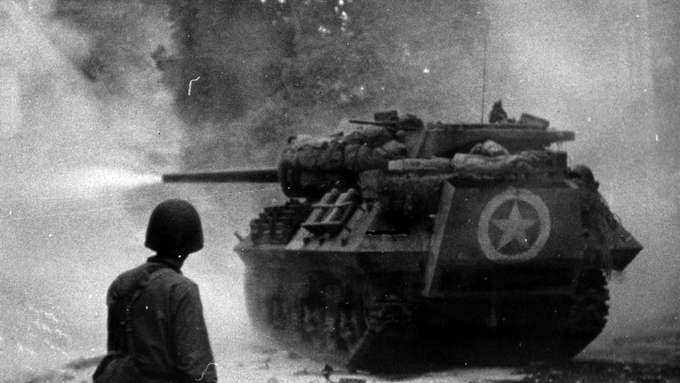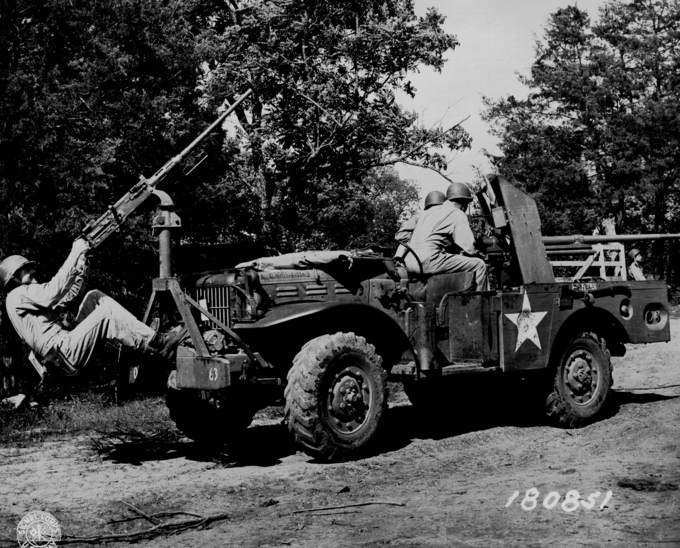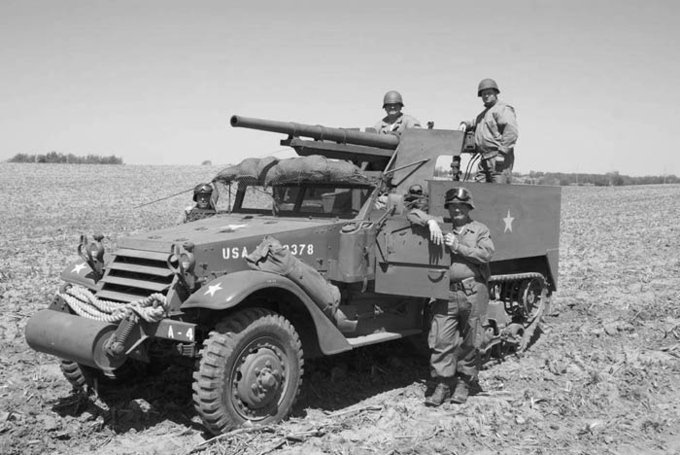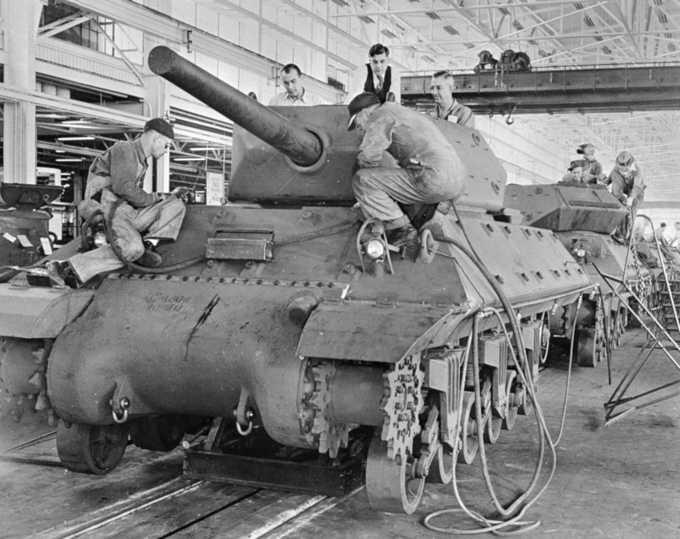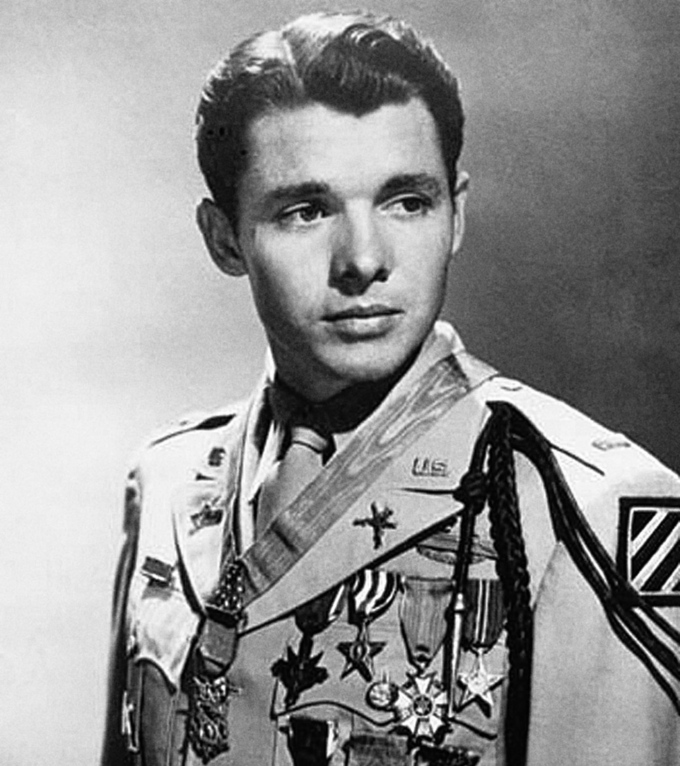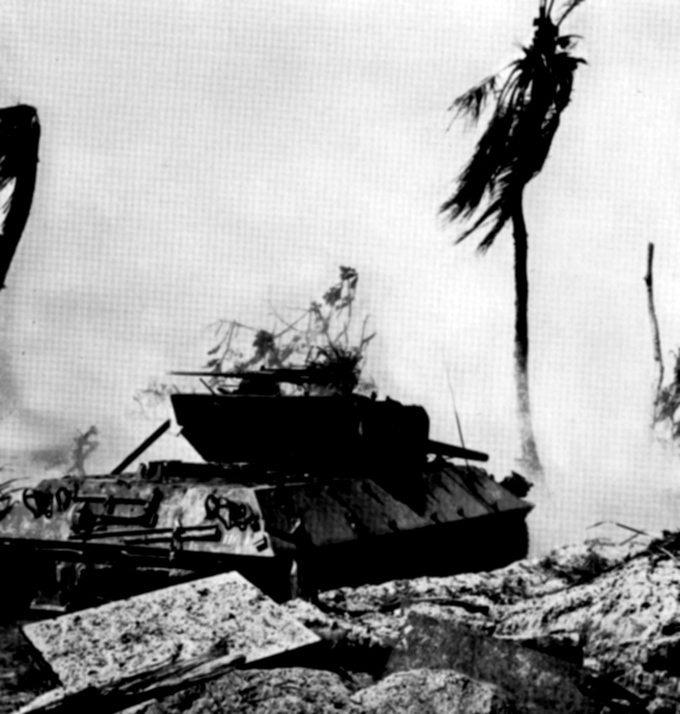The Fall of France led the United States to frantically find ways to counter the new threat profile of the German panzer divisions. This led to the formation of the Tank Destroyer Branch whose main purpose was to blunt any German armored exploitation attempts with a mobile tank destroyer force to eliminate the enemy tanks. While such a tank destroyer was in development, the urgency for a vehicle led to a conversion of a M4A2 hull with a larger, open-topped turret carrying a high-velocity 3-inch gun into battle. This weapon system would be adopted as the 3-inch Gun Motor Carriage M10.
U.S. Tank Destroyer Doctrine
In 1940, the German Blitzkrieg that overran Poland and France shocked the world by the effectiveness of the German armor. The standard anti-tank tactics used up to that point was for a line of anti-tank guns to be set up on a front, accompanying each infantry division. The problem was that the anti-tank guns were too thinly spread out to defend against a massed armored attack on a single location. In May 1941, Gen. Marshall, the U.S. Army chief of staff, ordered for a solution to this problem. The concept born from much discussion was to use a mobile anti-tank force that can be held in reserves and be deployed against a German armor attack, overwhelming the charging tanks with massed anti-tank power. The first few vehicles produced on this concept was the 37 mm GMC M6 and the 75 mm GMC M3.
While adequate, these were only seen as a stop-gap measure until better tank destroyers could be developed. The type of vehicles to make up this mobile reserve was under much contention between two men, Lt. Col Andrew Bruce and Gen. Lesley McNair. Bruce, the head of staff planning the tank destroyer force, wanted a fast vehicle with a powerful gun. McNair, the senior commander of Army Ground Forces, believed the best anti-tank weapon were the towed anti-tank guns. In November 1941, the new, independent Tank Destroyer Branch was formed at Camp Hood, Texas; headed by Bruce. Plans were made to form 53 tank destroyer battalions, and much more were ordered after the breakout of war for America in December 1941. Initially armed with only the half-tracks and wheeled vehicles with the 37 mm and 75 mm cannons, it was decided that a stronger weapon was needed for the new branch.
Development
Since the Tank Destroyer concept was made, there was a request for a 3-inch Gun Motor Carriage (GMC) design to become the standard tank destroyer. Up to 200 designs for a 3-inch GMC were sent from Ordnance for examination by the Tank Destroyer Board. Many were deemed unsatisfactory, but the urgency for vehicles had the Tank Destroyer branch prematurely standardize the 3-inch GMC M5 and M9 in January 1941 and May 1942 respectively. In November 1941, a proposal of a turret tank destroyer came in that would use the chassis of the new standard medium tank and armed with the 3-inch gun from the M6 heavy tank. The developed design would be designated the 3-inch GMC T35, an open-topped turret design. The initial design was an open traversable turret put on top of a chassis of the M4A2 Sherman.
Combat reports from the Philippines conflict against the Japanese forces came in and criticized vertical armor for being easy to penetrate by anti-tank weapons. The criticism prompted the T35 to be redesigned into the T35E1, which used a sloped side hull armor instead of a vertical design and lowered the overall silhouette. The T35 and T35E1 were then delivered to the Aberdeen Proving Grounds in April 1942 for testing and demonstrations. During the tests, the T35 were compared to the M5 and M9. The T35 proved automotively superior and more well-made than the other designs, and with their flaws brought into light, the M5 and M9 were soon cancelled.
The rejections of the two other vehicles left the T35 and T35E1 as the sole contenders in options for a tank destroyer. By 2 May 1942, the Army decided to standardize the T35E1 variant. Small changes were made to the designs, such as changing from a cast turret to a welded one and thinning of the armor from 1 inch to 3/4 inches. The thinning of armor caused concerns on the vehicle's survivability and another proposal was to add bosses to be added on the hull front and side for application of appliqué armor if needed. The vehicle was standardized as the 3-inch Gun Motor Carriage M10 in June 1942.
The Tank Destroyer command did not like the M10. They wanted a highly mobile 3-inch GMC and the usage of the M4 medium chassis meant the M10 did not move any faster than the standard medium tanks. Bruce himself saw the M10 as an obstruction to a true tank destroyer and as another expedient model akin to the 75 mm GMC M3. He continued his support on the T70 project, which would become the M18 Hellcat in 1943. The Army decided that an adequate vehicle was needed now and it was better than a perfect vehicle at a later date. Thus, the Army continued production of the M10, regardless of Tank Destroyer and Armored Forces’ opinions on it. The M10 was an adequate tank destroyer in that a single M10 costs about $47,900 to make while the M4A2 Sherman costs $60,200. The near 25% difference in price means the M10 could be produced in higher numbers for massed amounts of vehicles to act in the Tank Destroyer role.
Production started on the M10s in September 1942 at Fisher Tank Arsenal at Grand Blanc, Michigan. The urgency for the vehicles caused the production priority of the M10 to be class AA1, a rating much higher than even the M4 Sherman. The standard M10 used M4A2 chassis with the twin GM 6046 diesel engines, but there was a concern that there would not be enough of the M4A2 chassis for the conversion, so a second variant was developed using the M4A3 chassis with the Ford GAA gasoline engine. The gasoline variant, designated the M10A1, would enter production in October 1942 at Ford Motor Company. Production of these two vehicles would run until December 1943 (M10) and January 1944 (M10A1) for a total production number of 6,706 vehicle produced, 4,993 M10s and 1,713 M10A1s.
Today, the M10 is often referred to as the "Wolverine". However, the origin of this nickname is unknown. Some have contested that it was a British nickname, but it is unlikely as they gave it the designation "Achilles". It also is not an American nickname as well as all official documents referred to the M10's by their designation or "TD". It is widely accepted that "Wolverine" is a post-war nickname similar to the "Hetzer" nickname on the Jagdpanzer 38(t).
Combat usage
The first units to receive the M10s were the 776th and 899th Tank Destroyer Battalions. The Army committed the more numerous diesel-powered M10s to the front while the gasoline M10A1s stayed as training vehicles back in the states. The M10s saw their first action at the Battle of El Guettar on 23 March 1943. The 899th supported the 601st (equipped with the M3 GMC) and fought off the 10th Panzer Division. The battle ended with 30 of the 50 German tanks involved destroyed, with the 601st suffering a loss of 20 of their 28 vehicles and the 899th losing only seven M10s.
The Battle of El Guettar was the best example of the Tank Destroyers following their doctrine of moving reserve vehicles up to counter an enemy armored attack. After El Guettar, there was only sporadic armor engagements and thus the M10s were sent back to the reserves. One officer, Lt. Col. James Barney of the 776th, did not like the idea of the M10s and other tank destroyers being wasted in the rear lines and developed a tactic for these vehicles to be used in an artillery role. This was a role that the M10s would see most of their action in during the fighting in the Italy and even in the Normandy campaign. After the Tunisian campaign concluded, all the TD battalions still using the 75 mm GMC M3 were converted to use the M10s.
Despite its rather good performance in Africa, the M10 hit a snag when their usefulness was questioned. Some, like General Lucas, saw the TD branch as a failure; others, like General Patton and Bradley, saw their usage as being misplaced. These opinions and the field experience in Africa had McNair order for a change in TD policy in emphasis of the towed anti-tank gun, converting 15 self-propelled battalions to use towed guns. This change in direction for the tank destroyers caused a lowered interests on the M10s, and as such the M10 production would stop by the end of 1943. Regardless, M10s fought on in the combat theaters. The Italian Campaign did little to vindicate the M10s as it was found that the TD battalions were using 15,000 HE shells a month by December 1943 in the artillery fashion devised by Barney. The lack of major German armor presence forced the tank destroyers to take up an artillery role in Italy to be any form of use in the campaign. There were sporadic encounters with the new Ferdinands and Panther tanks against the M10, but these small encounters made little impact to the tank destroyer’s confidence in their firepower, leading to the belief that their guns were still adequate up until the Normandy Campaign.
When the Allies invaded France in June 1944, 30 TD battalions were present on the field. 11 were the towed while the rest had M10s or the new M18 Hellcats. The experience in France did show that the self-propelled mounts were much more preferable than the towed variants, the towed guns being too slow and unwieldy while providing little protection to the crew. Of the two gun mounts, the M10 became one of the most preferred tank destroyer in the campaign. This is because the M18 Hellcat was criticized for its thin 1/2 inch and that its main advantage, the high speed that Bruce had pushed for, fell short when the Tank Destroyer doctrine is made redundant with the lack of German armor present in Normandy.
Overall, the tank destroyers served in an infantry support role in most of the Normandy campaign, a role the M10 was not optimized in for many reasons. The open top exposed the crew to sniper fire and grenades, the thin armor could not withstand most German anti-tank weapons, and the lack of powered traverse in the turret caused the M10 to have a long traverse rate. Nevertheless, the M10s proved to be a very inspiring vehicle on the field and helped American soldiers push deeper into France. The first major tank engagement for the Americans in Normandy was around July 10 when the Panzer Lehr Division, made up of Panthers and other vehicles, attacked near Isigny. The 899th TD battalion stationed in the sector fought off the division. While the 899th destroyed 12 Panthers, the experience shocked the crews when they found the Panther invulnerable to frontal shots from the 3-inch gun. The realization that the M10s were now underpowered against the new German tanks caused a general complaint among the TD battalions for the fielding of a better gun on the field. The response to this would not come for three months, and in that time the TD crews had to make do with what they had.
As the Allies moved on into Fall 1944, the M10 tank destroyer units were undergoing a transition into the new 90 mm GMC M36, a M10 chassis with a turret armed with the more powerful 90 mm cannon. Though it was met with enthusiasm by the TD crews, the priority is low due to the low number of German armors encountered. The most important addition to the M10 units was the availability of the T4 HVAP rounds for the 3-inch gun. The new round allowed the M10s to penetrate a Panther’s mantlet from up to 1,000 yards, compared to the 200 yards with normal ammunition. Only 2,000 HVAP rounds came in November 1944, as such there was the issue of only being able to issue one HVAP round per M10. These shortages ensured that the tank destroyers were short-handed during the German offensive in the Battle of the Bulge. The M10, outnumbering the M36 and lacking adequate numbers of HVAP, faced against Panthers and Tiger IIs during the German Ardennes Offensive.
The impact of the battle led to renewed interest in improving the tank and tank destroyers, leading to more 76 mm M4 mediums and 90 mm M36 to arrive in Europe. An interesting situation in the Battle of the Bulge is a deception mission by the Germans named Operation Grief, which had ten Panther tanks dressed up to look like M10s externally to fool Americans. All of these mock-ups were destroyed by battle or scrapped after it. After the Battle of the Bulge, the majority of German armored forces have been dwindled and armor engagements largely declined in the final months of the war in Europe. One of the M10’s most notable action in 1945 was done on January 26 in the Colmar Pocket when the most decorated soldier of World War II, Audie Murphy, used a knocked out M10's M2 Browning machine gun to hold off a German counterattack of six tanks plus infantry while calling in artillery. He held for an hour and killed about 50 German soldiers from behind the burning M10 wreck, forcing the tank units to retreat due to loss of infantry support. Audie Murphy was awarded the Medal of Honor for his actions.
After the end of World War II, M10s and other tank destroyers in US service became obsolete as well as the tank destroyer doctrine. Mainly due to increasing prevalence of well-armored tanks that could do its job more efficiently such as the M26 Pershing, but also the lack of German AFVs at the time of the war and a study on ammo usage indicates that the tank destroyers spent more time supporting infantry with high-explosive shells than killing tanks with armor-piercing, rendering the tank destroyer section an unnecessary component in the modernizing armored forces.
Other usage of the M10s
M10s were also sent to the Pacific Theater against Japanese forces. However, the setting of the theater was unsuitable for mass usage of the tank destroyers; as such, only seven TD battalions were allocated. The M10s were first used on Kwajelin with the 7th Division, but their usage was restricted to simply substituting the armored forces. The M10s only saw usage as an infantry support vehicle due to the low number of Japanese tanks available in the campaign. The most action the M10s saw were at the Palaus Islands (Pelileu), Philippines, and Leyte. General reception of the tank destroyers in the Pacific Theater were unsatisfactory.
The M10s were a part of the American Lend-Lease program to the Allies and as such many M10s found their ways into British, Free French, and Soviet hands. In all, 1,855 M10s were sent in the Lend-Lease program, of which 1,648 were to Great Britain. The British designated the M10s as the 3" SPM (Self-Propelled Mount) M10. The most famous of the British usage of the M10 was the conversion of the armament into the 17-pounder gun. These converted M10s were designated M10C or M10 17-pdr under British nomenclature, though they did issue a name Achilles to designate all forms of M10 under British service.
After the war, most M10s were scrapped or given away as part of the Military Assistance Program to other allies. Its derivatives, the Achilles and the upgunned M36 GMC would see more usage in post-war service.
Bibliography
- Hart, Stephen A. Panther Medium Tank 1942-45. Great Britain: Osprey Publishing Ltd., 2003
- Moran, Nicholas. "US Tank Destroyer History." YouTube. YouTube, 26 Aug. 2016. Web. 08 Feb. 2017. Video
- Smithsonian Institution. "The Price of Freedom: Audie Murphy's Medal of Honor Citation." The Price of Freedom: Audie Murphy's Medal of Honor Citation. N.p., n.d. Web. 24 Feb. 2017. Website
- Walker, Dale L. "Audie Murphy: To Hell and Back." United Service Organizations. N.p., 20 Sept. 2015. Web. 24 Feb. 2017. Website
- Zaloga, Steven J. M10 and M36 Tank Destroyers 1942-53 Great Britain: Osprey Publishing Ltd., 2002
- Zaloga, Steven J. M18 Hellcat Tank Destroyer 1943-97 Great Britain: Osprey Publishing Ltd., 2004
- Zaloga, Steven J. M10 Tank Destroyer vs StuG III Assault Gun: Germany 1944 (Duel) Great Britain: Osprey Publishing Ltd., 2013
